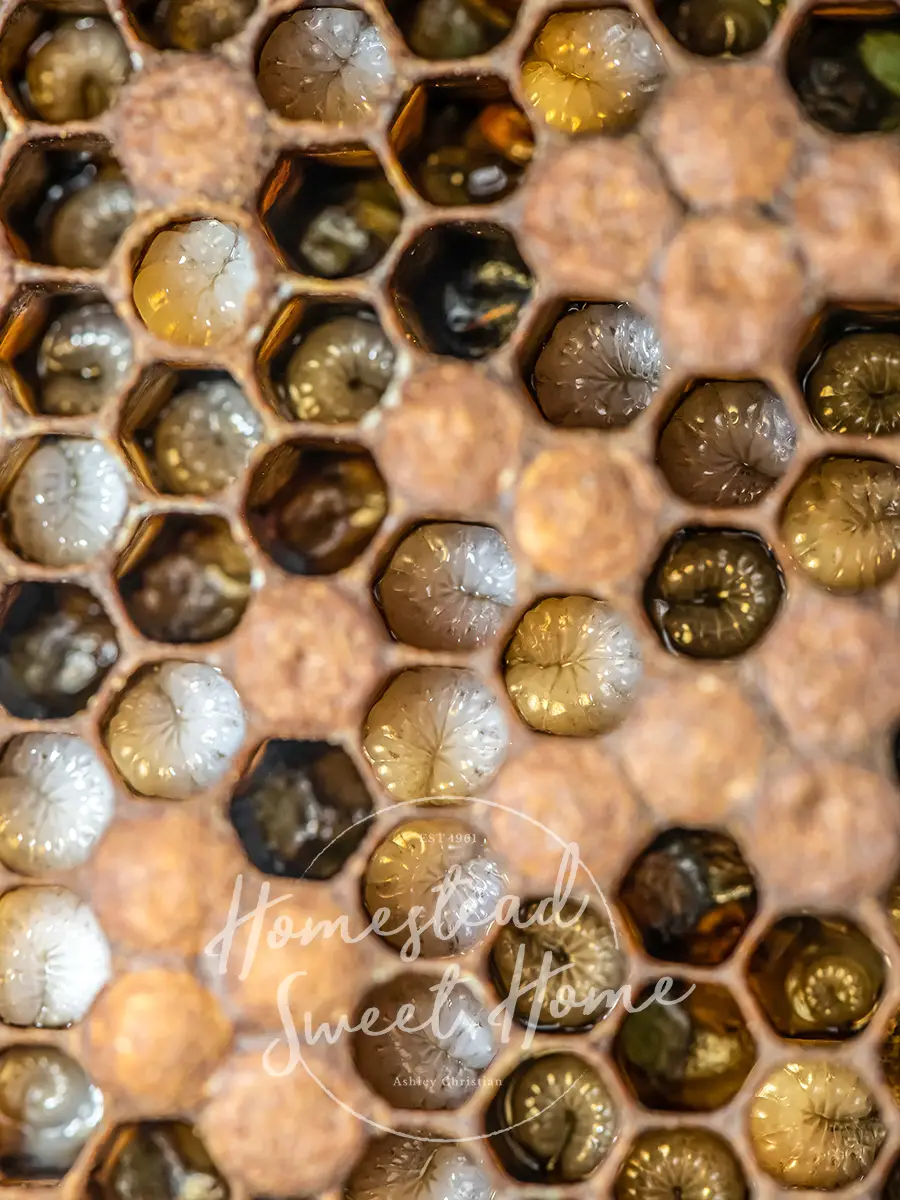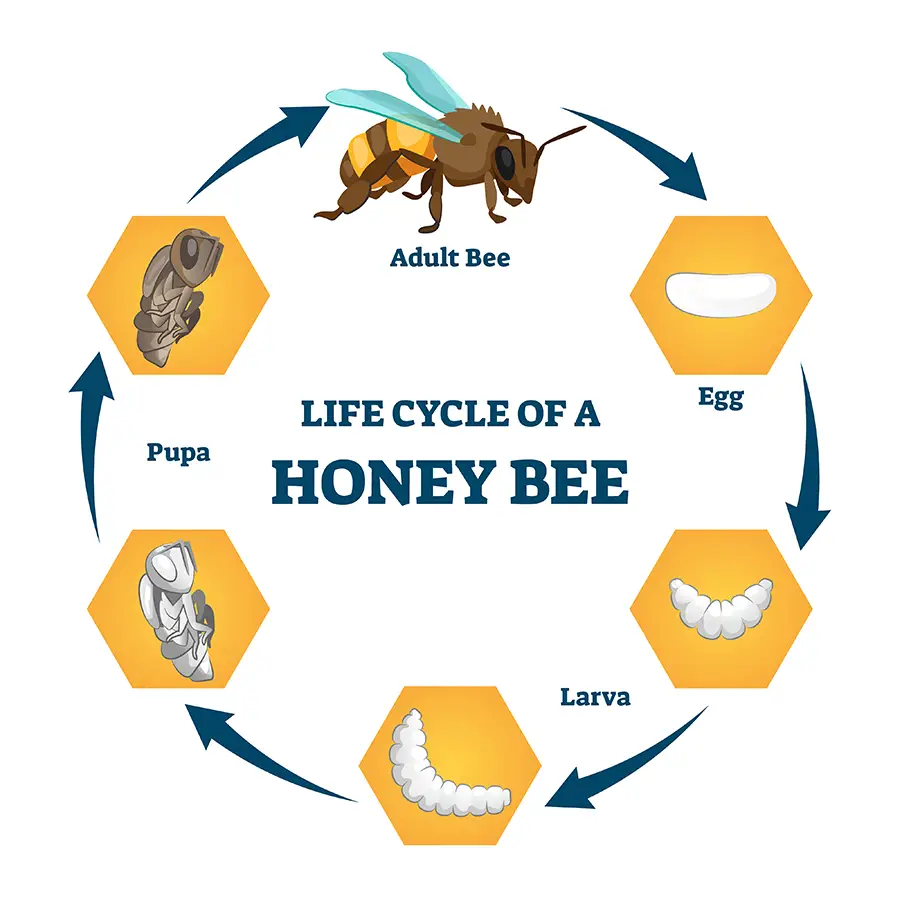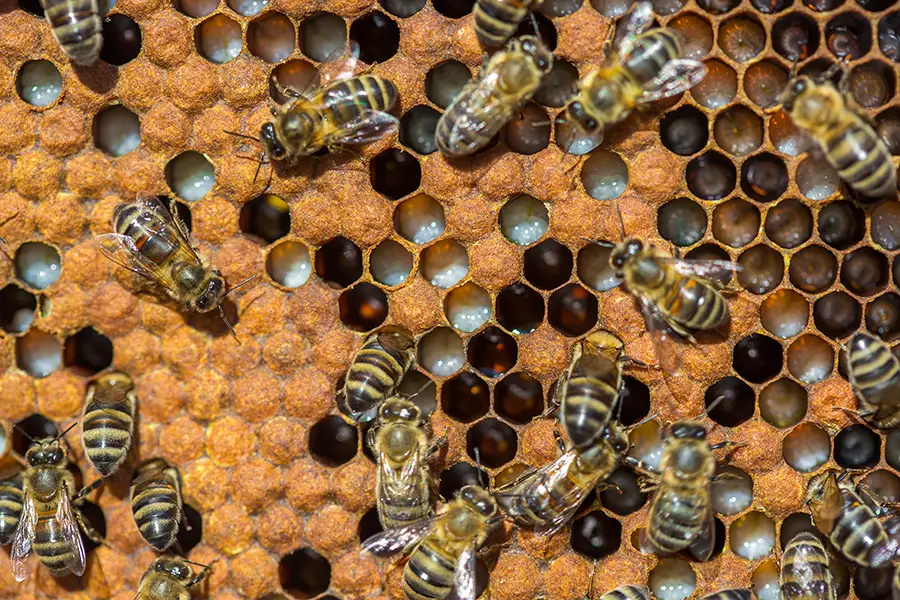Baby Bee – Lifecycles and Roles of the Honey bee

A baby bee goes through 4 cycles of life to become a fully grown bee. It begins as an egg, then becomes a larva, then a pupa, and finally an adult bee. Baby bee production is a crucial function of a hive because foraging bees will literally work themselves to death in the summer, only living for 6 weeks. This means they will need to be continually replaced with new worker bees in the spring, summer, and fall. Without baby bees, a colony would not survive.
What Do You Call a Baby Bee?
Baby bees in a hive are usually referred to as the brood. The brood includes all the developing eggs, larvae, and pupas. The queen will usually lay all her brood on combs on the side of the hive closest to the entrance. Then the honey storage will be on separate combs furthest from the entrance.
The brood is also referred to as the brood nest. In the most common type of hive, the Langstroth hive, the brood is in the bottom one or two boxes and is called the brood box.
Life Cycle of a Baby Bee
The life cycle of a baby bee goes through 4 phases, egg, larva, pupa, and the bee will emerge as a fully grown bee. Because bees emerge from their cells fully grown, you won’t see a baby version of a bee flying around, but rather a fully grown adult bee. Depending on which type of bee the egg will develop into, this will change how long the growth cycle takes.
- Drone Bees—24 days to adulthood
- Worker Bees—21 days to adulthood
- Queen Bee—16 days to adulthood

Egg Phase
The eggs are laid one in each cell of the comb. If given the option, bees will construct cells for the drones that are slightly larger than the cells for the worker bees to accommodate the drone’s larger size. Eggs for queen bees are laid in specially constructed cells called queen cells which are much larger than all the other cells.
It’s important to understand the life cycle of bees to keep them healthy. A common problem in honeybee hives is an infestation of varroa mites, which tend to reproduce themselves mostly in the larger drone cells. Read more about varroa mites and how you can treat your hive naturally to avoid the colony dying out in the winter.
Larva Phase
Baby bee larva looks much like grubs, though they are not technically maggots, they can resemble them. During the first three days of life, all larva, regardless of what type of bee they are to become, are fed royal jelly by nurse bees. Royal jelly is a milky secretion from the gland on top of the heads of nurse bees. After these first three days, worker and drone bees are fed bee bread, which is fermented pollen, while future queen bees are continuously fed royal jelly to develop their reproductive system.
The larva phase, also known as the feeding phase, lasts about the first six days as the larva grow rapidly and fill their cell.
Pupa Phase
Once the feeding stage is over, the worker bees will cap the top of the cell with old wax. This is now called capped brood. During the pupa phase, the baby bee will no longer be fed but will continue growing at a rapid rate.
Once the pupa is done growing and developing into an adult bee, which will vary according to the type of bee, they will chew through the dissolving capped brood cell and emerge as an adult bee.

What Does a Baby Bee Develop Into?
A baby bee or egg can develop into 3 potential types of bees. An unfertilized egg will become a male drone bee. A fertilized egg fed a mixture of royal jelly and bee bread will grow into a female worker bee. And a fertilized egg fed exclusively royal jelly will develop into a queen bee.
Drone Bees
Male Drone bees have a pretty tough life. Their only role in the colony is to mate with a virgin queen. Very few drones get the chance to mate as each queen only needs to mate with 10 to 20 drones during a single mating flight after she is newly hatched. And the process of mating causes the drone’s mating appendaged to be ripped out of his abdomen killing him in the process.
The hive will keep drones around for possible mating during the foraging season in spring through fall. But come winter since the drones are of no use, they are kicked out of the colony because they are unnecessary mouths to feed over the winter. They will freeze or starve outside of the warmth and provision of the winter hive packed with 40 to 90 lbs of honey. In the spring the colony will begin raising drones again.
The average lifespan of a drone is 90 days. Even though they are not given a place to live during the winter, and have no ability to feed themselves, they are necessary for the survival of the hive. They also supply needed genetic diversity to surrounding bee colonies. Bees can travel up to six miles, and the drones will gather in drone congregation areas for any local queens to mate with them.
Worker Bees
Worker bees make up the majority of the population of a colony. During the summer months, there can be as many as 50,000 to 90,000 bees in a single colony. Worker bees begin as fertilized female eggs, but they never develop reproductive abilities without a steady diet of royal jelly, which is only fed to queen bees, of which there is usually only one in a colony.
Once a worker bee hatches, she will become a nurse bee, or house bee right away. The nurse bees care for the developing eggs, larvae, and pupa by feeding them royal jelly and bee bread. Royal jelly is a milky secretion from the worker bee’s head, and bee bread is pollen that has been mixed with nectar and bee saliva and fermented, transforming it into a highly digestible high protein food.
House bees will also attend to the queen, clean the hive, build comb, and store food delivered by foraging bees. All worker bees spend the first three weeks after emerging from their cell as house bees. Afterward, their role will change to a foraging bee whose job is to collect nectar and pollen and return it back to the hive. All worker bees learn all the roles they could have in the hive, so if at any time the colony needs to split or swarm and leave the nest in search of a new home, they will all be able to assist in the survival of the colony.
When the flowering plants are blooming and there is nectar flowing and pollen to be found, the worker bees will be very busy foraging. During these seasons, worker bees will work themselves to death and only live about 6 weeks. They will be consistently replaced with new worker baby bees who will keep the work going.
In the wintertime when there is no pollen or nectar, the size of the hive will contract to around 30,000 bees. At this time, the worker bees can live up to 6 months, and they will huddle around the queen vibrating their bodies to keep the colony warm and the queen safe.
Queen Bee
Typically there is only one queen bee in a hive at a time. Queen bees can live up to 5 or 6 years, though 2 to 3 years is more common. The older a queen gets, the fewer eggs she will lay and the lower pheromones she will produce. When the colony senses the queen is getting too old, they will replace her with a process called supersedur. The worker bees will raise up several baby queen bees by feeding them only royal jelly to develop their reproductive system. The first queen to emerge will sting the other still developing queens and the old queen to death, leaving her as the sole new queen.
During the height of the nectar flow, the queen will lay up to 2,000 eggs per day. These eggs serve mainly to develop from a baby bee into a worker bee who will forage for pollen and nectar. The nectar is dehydrated by the bee’s wings and made into honey, which is then capped with wax and stored to feed the hive during the winter months.
Contrary to her name, the queen bee, she is not in charge of the colony. If anything the colony is in charge of her. The entire colony has the amazing God-given ability to always work for the greater good and survival of the colony, often sacrificing themselves in the process.
Can a Baby Bee Sting You?
Newly hatched bees do not develop the full use of their stinger for several days. Drone bees do not have stingers therefore they cannot sting. Once a worker bee’s stinger is fully developed after several days, she will die if she stings because her stinger is barbed and will be torn from her abdomen if used. Though queen bees have stingers, they are not barbed so she can use her stinger multiple times without dying. This is usually only done to sting a challenging queen to death.
How Are Baby Bees Born?
Though we sometimes refer to baby bees as hatching, they do not technically hatch. To be more precise they emerge after going through the egg, larva, and pupa phases. When the baby bee’s growth is complete, the wax capped cell it is growing in will dissolve. Sometimes the baby bee will chew her way out. This is especially true for emerging queen bees who are developed in a much larger cell. In fact, the worker bees will often help a queen bee emerge by chewing through her wax cell for her.
What about you, have you observed bee brood in a hive before? What are the best clues to know the difference in what you’re looking at? Let us know your experience with bee brood in the comments below.

Leave a Reply